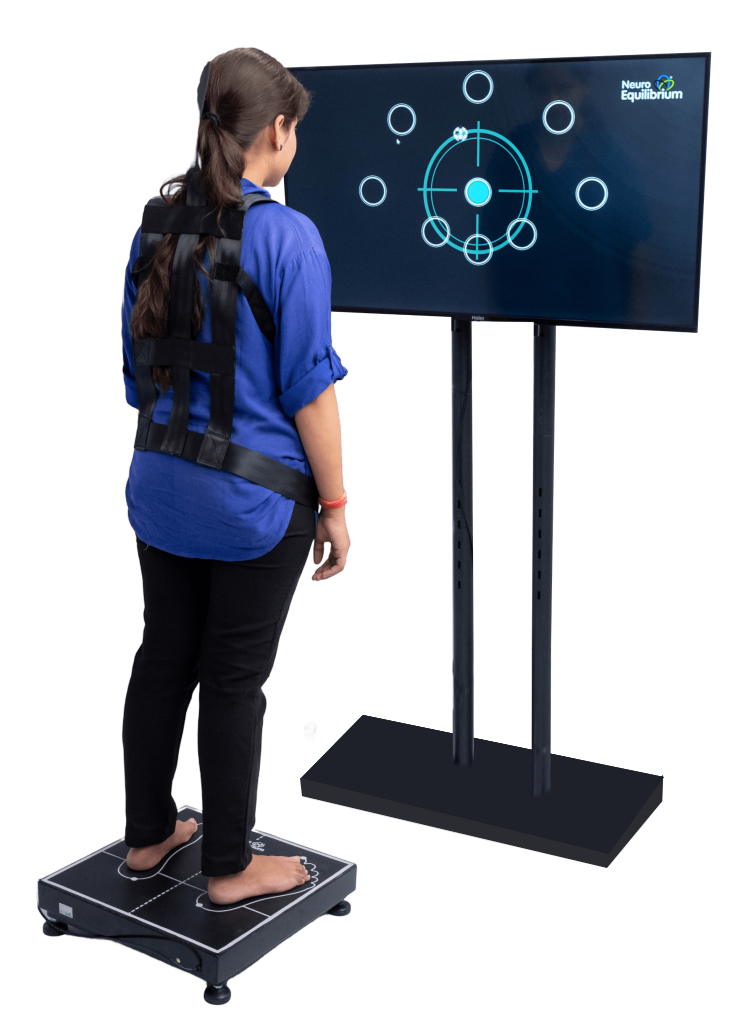






NeuroEquilibrium Computerized Stabilometry provides a comprehensive and reliable method for evaluating and improving postural control, aiding in effective diagnosis and treatment planning for balance disorders.
When you take a Computerized Stabilometry test, your balance is measured by noticing your control of movements. It helps the doctor confirm if your eyes, inner ears, and balance muscles are all working properly. When you feel like you’re lacking balance or have trouble staying steady, this test can look for the cause. Imagine that your doctor is hunting for any signs of balance issues in your body.
When you take a Computerized Stabilometry test, your balance is measured by observing how well you control your movements. It helps the doctor assess whether your eyes, inner ears, and balance muscles are functioning properly. If you often feel unsteady or have difficulty maintaining balance, this test can help identify the underlying cause by pinpointing where the imbalance may be coming from in your body.
It is simple to get ready for the test. Choose loose and comfortable outfits and footwear for the test. There are times when you will need to take off your shoes before the test. It is best to avoid eating a big meal just before exercising. Remember to mention all the medicines you’re taking to your doctor, since they can change the test results. To make things easier, remember the test will not harm you and is totally painless.
Getting ready for the test is simple. Wear loose, comfortable clothing and footwear, as you will need to remove your shoes before the test. Avoid eating a heavy meal immediately beforehand. It is important to inform your doctor about all the medications you are taking, as you may be asked to withhold certain ones for a day. Rest assured, the test is completely safe and painless.
During the test, you’ll stand on a moving platform while wearing a harness to keep you safe. The platform or the room might move slightly to see how you react. You might be asked to close your eyes or stand in different positions. The test doesn’t cause any pain and usually lasts less than 30 minutes. It’s a bit like a game to check how good your balance is!
After the test is over, your doctor will look at how well you are balanced during the various tasks. Based on the results, you can tell which areas of your balance system are fine and which might require support. Thus, your doctor can plan out exercises or therapies to support your balance. Remember that your results show you which areas you need to work on.
If your test shows balance issues, your doctor may suggest vestibular rehabilitation therapy. This includes exercises that improve your ability to stay balanced and strengthen your muscles that help your body to balance. You might practice standing on different surfaces, moving your head, or using virtual reality tools. The goal is to build your balance and reduce dizziness. Most people notice great improvements by practicing regularly.
Corporate Office:
140, Shrigopal Nagar, Gopalpura Bypass Road, Jaipur 302018, Rajasthan, India
Manufacturing Site:
1st Floor, Plot No.3, Pooja Tower, Muktanand Nagar, Gopal pura Mode, Jaipur, Rajasthan 302018
All rights reserved © 2024 NeuroEquilibrium Diagnostic Systems Pvt Ltd.
Vertigo Clinic in Ujjain | Vertigo Clinic in Barwani | Vertigo Clinic in Patna | Vertigo Clinic in Miraj | Vertigo Clinic in Kolhapur | Vertigo Clinic in Nashik | Vertigo Clinic in Jaysingpur | Vertigo Clinic in Amravati | Vertigo Clinic in Solapur | Vertigo Clinic in Pune | Vertigo Clinic in Aurangabad | Vertigo Clinic in Nagpur | Vertigo Clinic in Sagar | Vertigo Clinic in Indore | Vertigo Clinic in Jabalpur | Vertigo Clinic in Bhopal | Vertigo Clinic in Bilaspur | Vertigo Clinic in Ahmedabad | Vertigo Clinic in Vadodara | Vertigo Clinic in Surat | Vertigo Clinic in Navi Mumbai | Vertigo Clinic in Thane | Vertigo Clinic in Mumbai | Vertigo Clinic in Palghar | Vertigo Clinic in Jaipur | Vertigo Clinic in Sriganganagar | Vertigo Clinic in Alwar | Vertigo Clinic in Kota | Vertigo Clinic in Udaipur | Vertigo Clinic in Lucknow | Vertigo Clinic in Prayagraj | Vertigo Clinic in Varanasi | Vertigo Clinic in Gurgaon | Vertigo Clinic in Dehradun | Vertigo Clinic in Rohtak | Vertigo Clinic in Amritsar | Vertigo Clinic in Ludhiana | Vertigo Clinic in Greater Noida | Vertigo Clinic in Delhi | Vertigo Clinic in Kannur | Vertigo Clinic in Trichur | Vertigo Clinic in Cochin | Vertigo Clinic in Coimbatore | Vertigo Clinic in Tiruppur | Vertigo Clinic in Chennai | Vertigo Clinic in Hosur | Vertigo Clinic in Bangalore | Vertigo Clinic in Mangalore | Vertigo Clinic in Hyderabad | Vertigo Clinic in Sangli